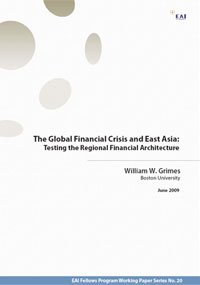
The Global Financial Crisis and East Asia: Testing the Regional Financial Architecture
워킹페이퍼 | 2009-06-30
William W. Grimes
EAI Fellows Program Working Paper Series No.20
요약문
The Asian Financial Crisis had a catalyzing effect on East Asian financial policy makers, as it laid bare both the exposure of regional countries to global finance and the apparent indifference to their plight on the part of the IMF and United States. Whatever else the crisis produced—and it had enormous economic, political, and social ramifications in many countries —it clearly raised concerns about the ability and willingness of the guarantors of global financial stability to care about East Asian stability. Some East Asian policy makers decided early on that the new dynamics of the global financial sys-tem called for a regional self-help sys-tem, as evidenced in the Asian Monetary Fund proposal and Japan’s New Miyazawa Initiative. After some stumbling around, cooperative efforts eventually coalesced around the ASEAN+3—a group that had not formally existed before 1997—in a set of cooperative endeavors that included preeminently the Chiang Mai Initiative, the Asian Bond Markets Initiative, the Asian Bond Fund (actually an initiative of the Executives’ Meeting of the Asia-Pacific Central Banks, which is composed mostly of ASEAN+3 central banks), and a rudimentary surveillance mechanism known as Economic Policy Review and Dialogue.
East Asian financial regionalism developed in response to the lessons of the AFC, and as such was meant to prevent such a crisis from recurring—or, if it did, to prevent its spread and to rapidly contain its worst effects. Regional cooperation has faced criticism on its economic merits both from those who argued that it had not gone far enough in locking in the lessons of the 1997 crisis and from those who felt that in “fighting the last war,” the East Asian economies were creating new global problems. There have been political concerns as well, both from advocates who fretted that politics was preventing the establishment of effective regional institutions and from those who doubted the viability of a set of arrangements that depended ultimately on Sino-Japanese cooperation to provide public goods.
저자
William W. Grimes, Associate Professor of International Relations, Director of the Center for the Study of Asia, Boston University.
 본 working paper는 "EAI Fellows Program on Peace, Governance, and Development in East Asia"에 제출된 논문이며, 온라인 버전으로만 배포됩니다. EAI Fellows Program은 대만 장경국 재단, 미국 헨리루스 재단의 후원으로 진행됩니다.
본 working paper는 "EAI Fellows Program on Peace, Governance, and Development in East Asia"에 제출된 논문이며, 온라인 버전으로만 배포됩니다. EAI Fellows Program은 대만 장경국 재단, 미국 헨리루스 재단의 후원으로 진행됩니다.
The Asian Financial Crisis had a catalyzing effect on East Asian financial policy makers, as it laid bare both the exposure of regional countries to global finance and the apparent indifference to their plight on the part of the IMF and United States. Whatever else the crisis produced—and it had enormous economic, political, and social ramifications in many countries —it clearly raised concerns about the ability and willingness of the guarantors of global financial stability to care about East Asian stability. Some East Asian policy makers decided early on that the new dynamics of the global financial sys-tem called for a regional self-help sys-tem, as evidenced in the Asian Monetary Fund proposal and Japan’s New Miyazawa Initiative. After some stumbling around, cooperative efforts eventually coalesced around the ASEAN+3—a group that had not formally existed before 1997—in a set of cooperative endeavors that included preeminently the Chiang Mai Initiative, the Asian Bond Markets Initiative, the Asian Bond Fund (actually an initiative of the Executives’ Meeting of the Asia-Pacific Central Banks, which is composed mostly of ASEAN+3 central banks), and a rudimentary surveillance mechanism known as Economic Policy Review and Dialogue.
East Asian financial regionalism developed in response to the lessons of the AFC, and as such was meant to prevent such a crisis from recurring—or, if it did, to prevent its spread and to rapidly contain its worst effects. Regional cooperation has faced criticism on its economic merits both from those who argued that it had not gone far enough in locking in the lessons of the 1997 crisis and from those who felt that in “fighting the last war,” the East Asian economies were creating new global problems. There have been political concerns as well, both from advocates who fretted that politics was preventing the establishment of effective regional institutions and from those who doubted the viability of a set of arrangements that depended ultimately on Sino-Japanese cooperation to provide public goods.
Both advocates and critics have built logical arguments based on theoretical and practical assumptions, but any honest evaluation has been left with the basic lingering question: When push comes to shove, what effects would financial regionalism have? With a new financial crisis of global dimensions, this would appear to be a good time to attempt at least an initial appraisal. The thesis of this paper is a paradoxical one. I argue that, while financial regionalism per se has had little apparent impact on how the crisis has affected the ASEAN+3 economies, the regional financial architecture has effectively insulated these economies from the worst effects of the crisis. The catch is that “regional financial architecture” must be understood as more than simply the official cooperative efforts of ministries of finance and central banks. Rather, it also includes the responses of national authorities and global actors to the political dynamics created by regional and global institutions. And ironically, it is far from obvious that “improvements” in the form of greater institutionalization of regional financial cooperation will improve either the functioning of the regional initiatives themselves or the more broadly defined regional financial architecture.
무역ㆍ기술ㆍ에너지 질서의 미래
디지털 경제 시대와 한국의 경제외교